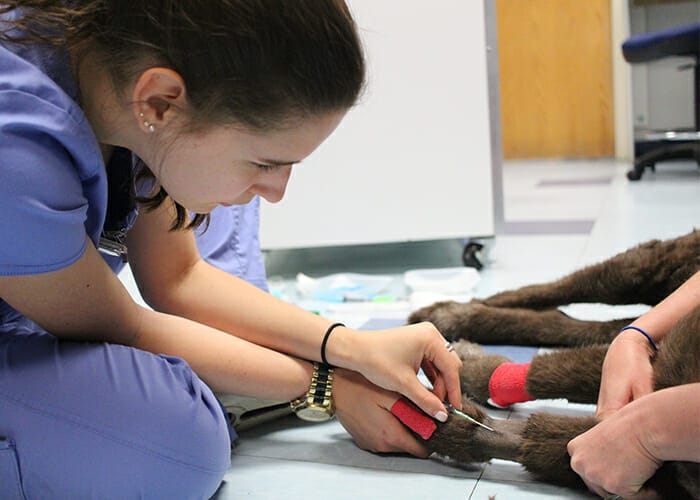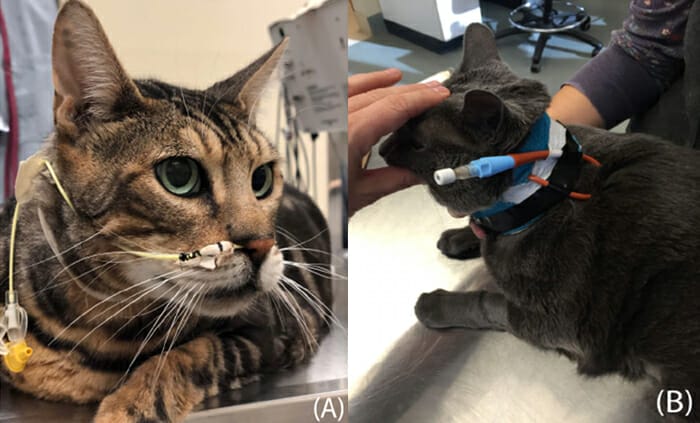Internal Medicine, Emergency Medicine
Pancreatitis in Pets: Understanding Signs and Treatment
Located by the stomach, the pancreas makes and releases enzymes that aid in digestion. Normally, these enzymes are not active until they reach the small intestine. However, with pancreatitis the enzymes activate too early and irritate the pancreas and surrounding tissue. This leads to pancreatitis, or inflammation of the pancreas.
Pancreatitis is often an acute problem causing gastrointestinal signs of vomiting and/or diarrhea along with abdominal pain that can progress rapidly. Recurrent bouts can have long-term consequences including repeated hospitalizations and development of chronic pancreatitis. Early diagnosis and treatment are therefore recommended to prevent complications and improve your pet’s quality of life.
How do Pets Get Pancreatitis?
In most cases, the cause of pancreatitis is unknown in both cats and dogs. Some pets experience acute pancreatitis, meaning it comes on suddenly. Other pets have chronic pancreatitis where it develops over time. Both types can range from mild to severe and can be quite painful.
A variety of risk factors may predispose pets to pancreatitis:
- Dietary indiscretion – if your pet has a history of eating anything and everything.
- Genetics – certain breeds such as Miniature Schnauzers and Yorkies are more prone to developing this condition.
- High–fat diets – especially for pets that get large amounts of fatty food at one time.
- Medications – some medicines can cause side effects by raising blood fat levels.
- Other concurrent diseases – conditions such as cancer, diabetes mellitus, chronic gastrointestinal disease, liver disease, hypothyroid disease, and Cushing’s disease in dogs.
- Prior surgery or trauma.
Signs of Pancreatitis in Pets
Clinical presentation in cats and dogs can be nonspecific. Patients with acute pancreatitis often present for gastrointestinal signs of vomiting, diarrhea, abdominal pain, distended abdomen, dehydration, fever, and yellow tinge to their eyes, inner ears, or skin. Patients with chronic pancreatitis may have mild signs including anorexia, decreased appetite, and lethargy.
Diagnosing Pancreatitis in Pets
Due to the nonspecific nature of the signs, diagnosing pancreatitis includes ruling out other causes of anorexia, vomiting, diarrhea, and abdominal pain. It is important to let your veterinarian know about all the medications that your pet may be on to ensure those aren’t causing the symptoms. Your pet may also be tested for other diseases if there is clinical suspicion. Take note of and discuss symptoms like increased drinking, increased urination, changes in energy level, hair loss, and weight changes (loss or gain) with your veterinarian. These may be helpful to diagnose other conditions.
Your veterinarian will typically perform abdominal radiographs (X-rays) first to rule out gastrointestinal foreign bodies. Patients with pancreatitis can show some mild changes on abdominal X-rays, however abdominal ultrasound is often necessary for diagnosing pancreatitis.
Your pet may also have blood tests.
- Routine lab tests can reveal a high white blood cell count, low platelets, high kidney values, electrolyte abnormalities, and high amylases and lipases (enzymes). Urine testing is helpful to look for signs of diabetes and infection. These enzymes can be made and secreted by many organs in the body, so regular lab work may not be enough.
- Additional specialized bloodwork may be completed. One test, a cage-side rapid test (SNAP cPL and fPL), is available at many veterinary clinics. These rapid tests are helpful to rule out pancreatitis as a negative result indicates the Patient most likely does not have pancreatitis. In the case of a positive SNAP test, another specialized test (Spec cPL and fPL) is used to confirm the diagnosis and achieve a baseline value to help monitor the disease in the future.
- Because of potential overlap with other underlying conditions such as exocrine pancreatic insufficiency and hepatitis, other screening tests may be recommended. Your veterinarian may want to measure vitamin B12 and folate levels which could indicate underlying malabsorption and gastrointestinal disease.

Treating Pancreatitis
Unfortunately, there is no single antidote for pancreatitis, and supportive medical care is critical in acute pancreatitis patients. The good news is surgical intervention is rarely necessary. Instead, your pet may be admitted for intravenous fluids, especially if they haven’t been eating or drinking or have vomiting or diarrhea. In–hospital monitoring of patients includes regular monitoring of vital signs, blood pressure, hydration status, blood glucose, and bloodwork including electrolytes. Your pet will receive pain medications intravenously while in the hospital, and you will most likely have oral pain medication sent home with you.
Anti-nausea medications are also an important part of pancreatitis management. Your veterinarian may prescribe a combination of these medications. Commonly prescribed medications include maropitant, ondansetron, and metoclopramide. Your pet may also benefit from appetite stimulants such as mirtazapine or capromorelin. Antacids, such as omeprazole and sucralfate, do not have direct benefits on pancreatitis itself but may be prescribed if there are concurrent gastrointestinal issues.
The Importance of Nutrition
Nutrition is important in the treatment of pancreatitis. Often pets have not been eating well for days so withholding food is not recommended. Instead, pets with mild pancreatitis may start eating slowly with supportive care. If your pet’s appetite doesn’t return within 48 hours, then feeding tubes may be recommended.
Feeding tubes can also be used for hydration and administering medications. Tubes are typically well tolerated in cats and dogs with few complications.
- Nasogastric tubes are placed in the nose and go down into the stomach. These are usually considered first as placement requires only mild sedation. These tubes allow for short–term liquid diet feedings in the hospital.
- Esophagostomy tubes are placed in the esophagus. These larger tubes allow for longer term feeding of canned foods blended with water.
For Dogs
In dogs, an ultra-low-fat diet is recommended. It may be a prescription diet or a homemade diet. However, sick pets may need to be enticed with bland foods such as boiled chicken, white rice, cottage cheese, and chicken baby food. Homemade diets for long–term management are also an option. A nutritionist consultation may be helpful to make sure the pet has a balanced diet.
For Cats
A low–fat diet is not recommended in cats due to their higher need of fat in their diet. Chronic pancreatitis in cats is treated similarly to cats with chronic intestinal disease (such as inflammatory bowel disease). Your veterinarian my prescribe a novel protein or hydrolyzed diet (one in which protein is already broken down). However, in acute pancreatitis cases, especially with prolonged anorexia, the focus is to entice cats to eat. In these cases, a variety of foods including diets labeled “gastrointestinal diets” may be fed in the hospital with hopes of transitioning to novel protein or hydrolyzed diets at home later. One notable concern in cats with pancreatitis is development of hepatic lipidosis, or “fatty build-up” in the liver, due to prolonged anorexia. Nutritional support is required for these pets.

Nasoesophageal (A) and esophagostomy (B) tubes being used in hospital for nutritional support.
Long-term Management
Your veterinarian will typically discharge your pet once they are no longer having vomiting or regurgitation, eating on their own, and/or tolerating feedings via esophageal feeding tubes. Your veterinarian will typically want a checkup one to two weeks after discharge to see how your pet is doing and discuss long–term therapies. As noted, long–term diet therapy is important for chronic pancreatitis in both cats and dogs. In patients with concurrent diseases, consultation with a veterinary nutritionist would be of benefit to help find a homemade or existing pre-made diet that would be best for all diagnosed conditions. Managing these other conditions is important to prevent acute pancreatitis episodes.
Because pancreatitis can vary in the way it presents, there is a wide range of outcomes. It depends on the severity, the extent of pancreatic necrosis, complications, and any concurrent diseases. Chronic pancreatitis remains a concern for pets with recurrent, acute pancreatitis episodes and continued treatments (such as diet and long–term medical therapy) may be recommended to prevent additional episodes.
If you think your pet may be experiencing pancreatitis, contact your family veterinarian. If they’re unavailable or you believe your pet needs emergency care, find your nearest MedVet.